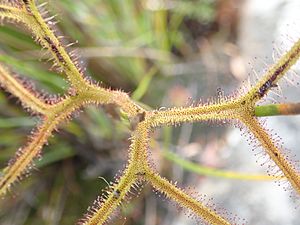Forked sundew facts for kids
Quick facts for kids Forked sundew |
|
|---|---|
 |
|
 |
|
| Scientific classification | |
| Genus: |
Drosera
|
| Species: |
binata
|
 |
|
| Occurrence data from AVH | |
| Synonyms | |
Drosera binata, also known as the forked sundew or fork-leaved sundew, is a large perennial plant. This means it lives for more than two years. It is a type of sundew that grows naturally in Australia and New Zealand. Its scientific name, binata, comes from Latin and means "having pairs." This name refers to its unique leaves, which split into two parts, looking like a fork.
Like all sundews, the forked sundew is a Carnivorous plant. It stands out because its leaves are narrow and branch out. It is the only species in its special plant group, called a Drosera subgenus Phycopsis.
You can find D. binata in Australia, mostly along the coast. It grows from Fraser Island in Queensland, down through New South Wales and Victoria, to Tasmania and the southeast part of South Australia. It also grows in New Zealand, commonly found below 1000 meters in both the North and South Islands, Stewart Island/Rakiura, and even on the Chathams. Some of these plants rest during winter, while others grow all year round.
Contents
How Scientists Study and Name the Forked Sundew
Scientists have been studying the forked sundew for a long time. Plants like the first one ever collected, called the "T-form," were found in 1792. This was during a French exploration of Australia's southern coast. A naturalist named Jacques Labillardière was the first to officially describe D. binata in his book about Australian plants in 1804.
Different Forms of the Forked Sundew
The "T-form" is named because its single leaf splits into a "T" shape. These plants are strong and can grow up to 30 centimeters (about 12 inches) tall. Their leaves are green but turn red as they get older. This form is known to be very stable, meaning it usually looks the same.
Another type of forked sundew is often called "var. dichotoma." This form looks similar to the T-form but has yellower leaves. Its leaves usually split into four points, though sometimes they can have as many as eight. This form was first described in 1819. Even though its original name is now considered a synonym (another name for the same plant), people still use "var. dichotoma" to talk about this specific type. Charles Darwin, a famous scientist, even used this plant in his studies on carnivorous plants for his 1875 book, Insectivorous Plants.
There are other interesting forms too! One is called "f. multifida." This type has even more leaf divisions, splitting many times to create anywhere from eight to 16, or even 30, leaf points. Another form, known as "f. extrema", can produce up to 40 leaf points. These names are not officially recognized by all plant naming rules, but people who grow carnivorous plants often use them.
Special Cultivated Varieties
Scientists and growers have also named two special cultivated varieties, called cultivars, of D. binata.
- Drosera 'Giant' is a very large version of the "var. dichotoma" type. It was named in 1998.
- Drosera 'Marston Dragon' was named in 1986. These special names help people identify these unique plants.
See also
 In Spanish: Drosera binata para niños
In Spanish: Drosera binata para niños

